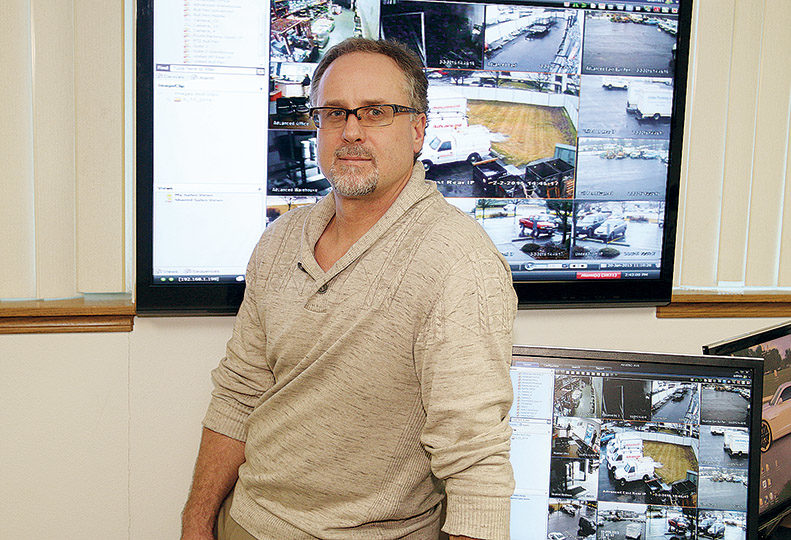
Security system features, controls are going mobile
Integrated capabilities fueling rise in demand

Advances in electronic security systems are bringing new capabilities into the mainstream, says Jay Hunt, president of Spokane-based Allied Fire & Security Inc.
Depending on the services they desire, security system customers can use their smartphones, computers, or other Web-enabled devices to arm and disarm their systems remotely, view live security video on demand and receive text and email alerts when alarms are triggered, Hunt says.
Many systems today also come with capabilities to control locks, lighting, and heating systems remotely.
Hunt says the combination of mobile controls and video features is stirring growing interest in integrated security systems.
“With automation, energy management, and life-safety features, people are wanting this stuff,” Hunt says.
“You can turn the system on and off remotely. You can open and close the locks, without giving anyone else access to your home,” he says, adding “Through applications for computers or smartphone, you’re able to access the cameras and watch things live.”
Rusty Imes, president of Advanced Electric & Alarm Systems Inc., of Spokane, says mobile controls for alarm systems are some of the most popular features people are requesting.
“About 90 percent of the systems we put in have applications that people have on their smartphones,” he says.
Video verification is an up-and-coming alarm system feature, Imes says. A system with video verification sends live or captured video images to a customer or professional monitoring service when activated by motion, sound, or a panic alarm.
One proprietary video verification system, called Videofied, sends a video clip to a central monitoring station and the customer, enabling them to see what caused the alarm, he says.
The central station operator and the customer can view the video alert to determine whether the cause of the alarm is an intruder and whether to dispatch law enforcement to an event in progress.
If the video shows an intruder, the central station calls law enforcement with a verified alarm.
Isaac Walton, sales manager at Advanced Alarm, says video verification reduces false alarms and leads to faster law enforcement response to a crime in progress.
“When they have a verified alarm, police will get there quicker,” Walton asserts.
Repeat false alarms, however, could result in slower response times and fines.
Advanced Alarm has been selling and servicing systems with video verification capabilities for about a year.
Imes says a video verification system at one business has resulted in a total of five arrests during two separate incidents.
“They were caught on site trying to steal stuff,” he says.
Imes says word of one arrest quickly led to two new customers.
“Referrals are incredible,” he says. “Once we put this system in, (customers) tell everybody.”
Walton says a single-camera system costs under $1,500 with the average system costing $2,500 to $3,000. Central monitoring starts at $60 a month, he says.
Monthly fees are based partly on data usage, because the systems usually transmit and receive information through a cellular phone network, he says.
Imes says Advanced Alarm serves mostly commercial customers, although the company also is seeing an uptick in residential customers.
Advanced I-View, another intrusion detection system with video verification capabilities, offers real-time video surveillance, which customers can access with their smartphones or computers, he says.
The system provides a cost-effective bridge between conventional intrusion alarms and closed-circuit video systems, Imes says.
Some video verification systems feature a panic button, which sends live video to the central monitoring station when activated.
“If someone pushes a panic alarm, the central station would see it and provide a description of the situation to authorities,” Imes says.
The panic-alarm feature is ideal for schools, banks, and convenience stores, he says. A growing number of car lots also are using the system.
Allied Security’s Hunt says his business, which also operates branches in Seattle and Portland, handles mostly residential sales, although a growing number of sales are going to small businesses.
A popular residential system is Total Connect, which is manufactured by Honeywell International Inc.
“A large amount of people are requesting at least the ability to turn the security system on and off with a cellular phone,” he says.
Lighting control and automation of lighting is another feature that integrates well in security systems.
“Modules plug into an outlet and into lamps or devices and connect wirelessly to the security system,” he says, adding that the modules can be turned on or off through a remote app or security system presets.
Another security feature can turn lights on where and when a motion sensor is tripped.
“What I like and my wife likes is that if the system is tripped at night, lamp modules automatically go on, so we can see what’s going on,” Hunt says.
The system also sends alerts via text or email with attached video clips so the customer can see what triggered a motion sensor and verify whether it’s an intruder and whether authorities should be summoned.
“My home system will send me an alert by text or email,” Hunt says. “If there’s movement at the front door, the system will pick it up and send a 10-second clip of what’s happening. In lot of cases, it’s the kids coming home.”
Total Connect also has some business applications.
“Small businesses are using the Total Connect system for watching what’s going on,” he says. “The system also can be used for internal security. If you go into bigger, more industrial-type system with digital video recording cameras and very clear pictures, it’s more expensive.”
Automation packages start at $199 installed, and monthly monitoring rates range from $28 to the low $40s, Hunt says.
Monitored fire-safety devices can be especially valuable when no one is on the premise to report a fire, he says.
“With life-safety or fire-safety devices, authorities come whether you’re there or not,” he says.
